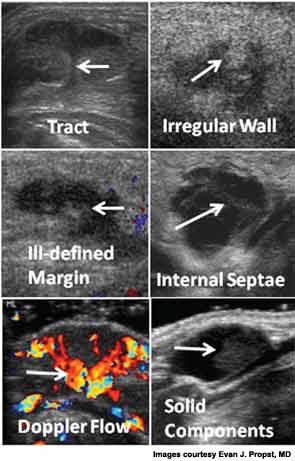There are several problems with such an overly aggressive approach, Dr. Propst said. First and foremost, the amount of tissue being removed during a Sistrunk is far more extensive than that removed for a dermoid cyst, due to the location of the mass. Furthermore, patients who undergo a Sistrunk often require a postop drain, Dr. Probst added.
Explore This Issue
July 2013Mary Beth Cunnane, MD, a staff radiologist at the Massachusetts Eye and Ear Infirmary and an instructor at Harvard Medical School, both in Boston, said the study findings are potentially practice changing. “Like most of my colleagues, I’ve often struggled with making a differential diagnosis of these masses using ultrasound images,” Dr. Cunnane, who was not involved in the study, told ENTtoday. “Now, using these ultrasound features, I can be much more definitive in my radiology reports. I certainly plan on using this in my practice.”

Clues to Drainage
Leila Mankarious, MD, a pediatric otolaryngologist at Massachusetts Eye and Ear Infirmary, has conducted studies into why patients who undergo a Sistrunk procedure sometimes develop post-operative cervical fluid accumulations (Otolaryngol Head Neck Surg. 2009;140:343-347; 2011;144:888-890). Among her findings is the fact that salivary tissue is often present several milimeters above the hyoid bone.
“That finding was significant because the surgeon may believe he or she is doing a more thorough operative procedure by removing tissue above the hyoid bone, but actually may be disrupting salivary tissue that induces post-operative fluid accumulation,” said Nancy M. Bauman, MD, professor of otolaryngology-head and neck surgery at Children’s National Medical Center in Washington, DC, and an ENTtoday editorial advisory board member. “The treatment of post-operative fluid can be tedious for both the surgeon and family, not only because of discomfort but because it makes one wonder if the TGDC was not completely excised,” Dr. Bauman said. “Dr. Mankarious’ research suggests that it may not be residual TGDC that’s the culprit, but instead disrupted salivary tissue that is causing the fluid accumulation.”
But whatever the cause, the take-home message is clear, said Dr. Bauman. “More accurate pre-operative diagnosis will obviate the need to do a Sistrunk procedure on every midline neck mass.”
Dr. Propst shares Dr. Bauman’s concerns that applying the Sistrunk procedure too broadly has several downsides. “We actually put our TGDC patients in an observation bed because of the risk that they may develop swelling of the tongue, which needs to be watched closely,” he said. “This really complicates post-op care.” Thus, “it would be a huge benefit if we could limit those more extensive excisions to cases where we really are nearly 100 percent certain that a TGDC is in fact a TGDC, and not a dermoid cyst in disguise.”
Leave a Reply